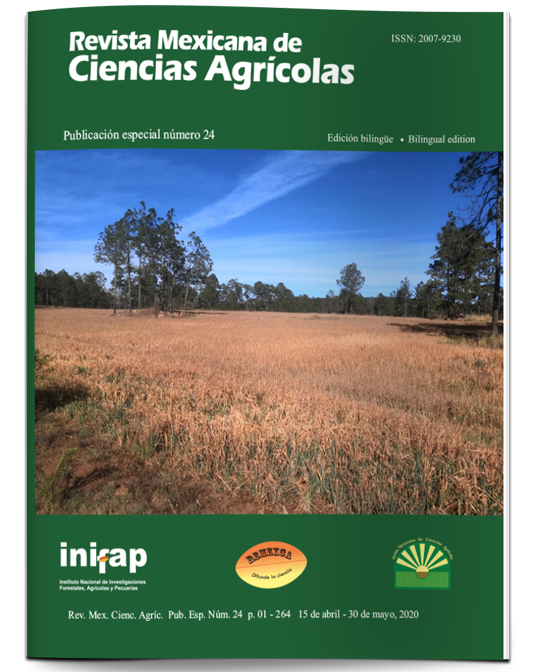Forage accumulation, morphological composition and light interception in Triticale 118 (X Triticosecale Wittmack)
DOI:
https://doi.org/10.29312/remexca.v0i24.2372Keywords:
Triticosecale Wittmack, cereals, growth, phenological stageAbstract
The objectives were to obtain the forage accumulation curve, morphological components and light interception to determine the optimal cutting time for green forage of Triticale 118. The study was carried out in Texcoco, State of Mexico, under an irrigation system, during the winter of the year 2012-2013 (cycle 1) and 2013-2014 (cycle 2). The harvest was carried out every seven days, starting at 43 days after sowing (dds) and until the forage accumulation decreased. The average height of 20 plants, intercepted radiation (IR), dry matter accumulation, morphological composition and leaf area index (LAI) were recorded in each harvest. In cycle 1 the maximum forage accumulation was obtained at 84 dds with a yield of 1 852 kg of DM ha-1, in the gleaning stage, an IR of 75% and a plant height of 52 cm were obtained, but due to a frost, it was not possible to continue sampling. In the case of cycle 2, the maximum forage accumulation occurred at 119 dds with a value of 8 733 kg of DM ha-1, where the optimal cutting moment was between 77 and 91 dds, when the plant reached an IR of between 85 and 86%, LAI between 2.3 and 3.2, respectively, and an average of 58 cm. In this experiment, it was established that, with the IR, LAI and height, the optimum harvest time for Triticale 118 can be defined, obtaining quality forage.
Downloads
Downloads
Published
How to Cite
Issue
Section
License
The authors who publish in Revista Mexicana de Ciencias Agrícolas accept the following conditions:
In accordance with copyright laws, Revista Mexicana de Ciencias Agrícolas recognizes and respects the authors’ moral right and ownership of property rights which will be transferred to the journal for dissemination in open access. Invariably, all the authors have to sign a letter of transfer of property rights and of originality of the article to Instituto Nacional de Investigaciones Forestales, Agrícolas y Pecuarias (INIFAP) [National Institute of Forestry, Agricultural and Livestock Research]. The author(s) must pay a fee for the reception of articles before proceeding to editorial review.
All the texts published by Revista Mexicana de Ciencias Agrícolas —with no exception— are distributed under a Creative Commons License Attribution-NonCommercial 4.0 International (CC BY-NC 4.0), which allows third parties to use the publication as long as the work’s authorship and its first publication in this journal are mentioned.
The author(s) can enter into independent and additional contractual agreements for the nonexclusive distribution of the version of the article published in Revista Mexicana de Ciencias Agrícolas (for example include it into an institutional repository or publish it in a book) as long as it is clearly and explicitly indicated that the work was published for the first time in Revista Mexicana de Ciencias Agrícolas.
For all the above, the authors shall send the Letter-transfer of Property Rights for the first publication duly filled in and signed by the author(s). This form must be sent as a PDF file to: revista_atm@yahoo.com.mx; cienciasagricola@inifap.gob.mx; remexca2017@gmail.
This work is licensed under a Creative Commons Attribution-Noncommercial 4.0 International license.



